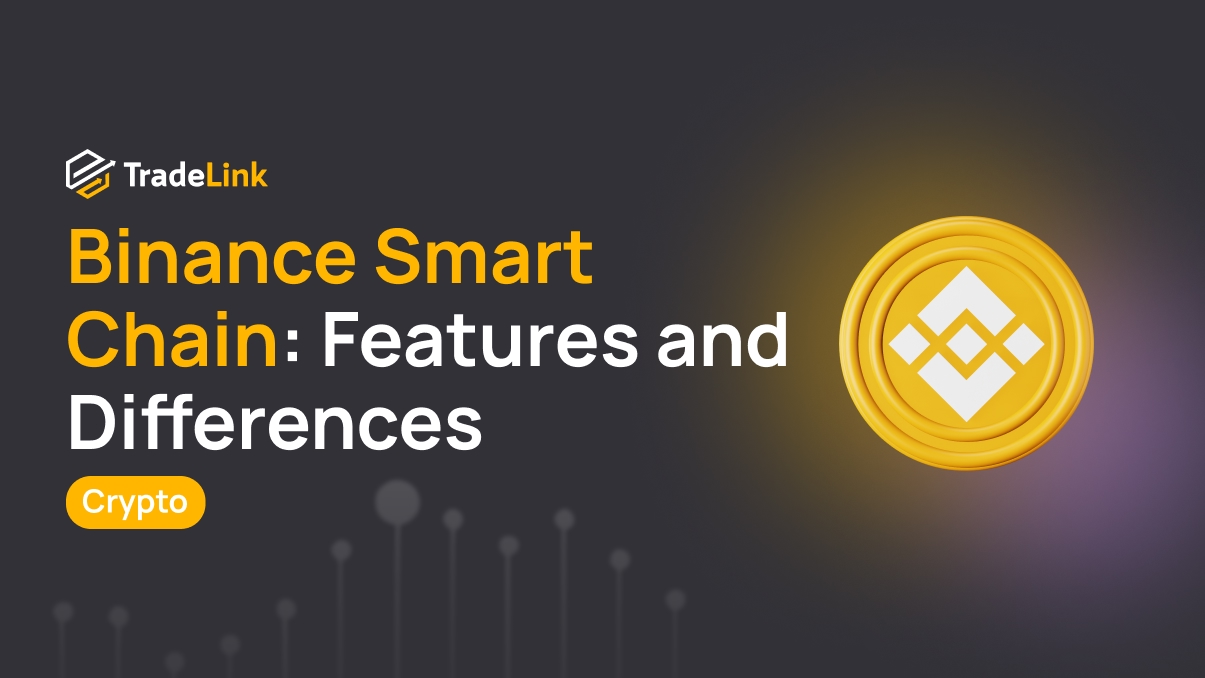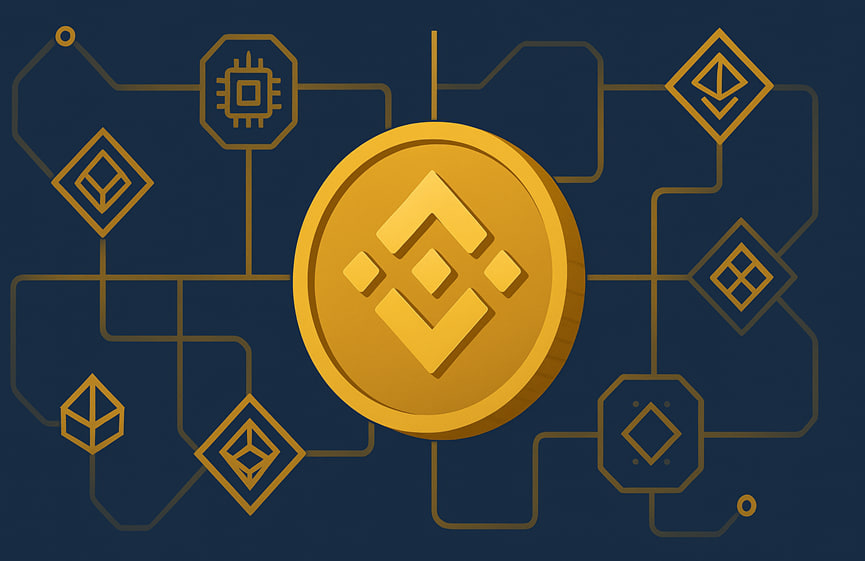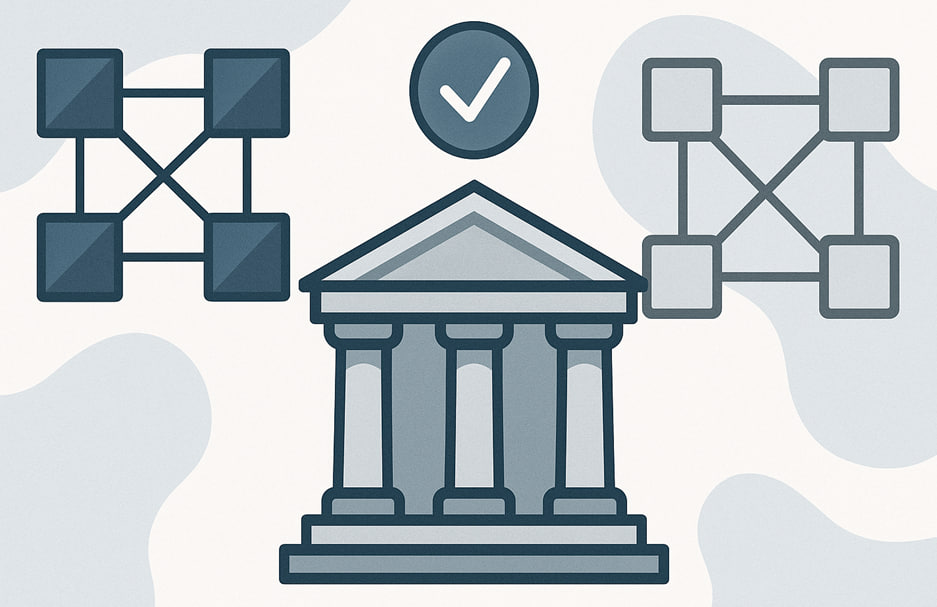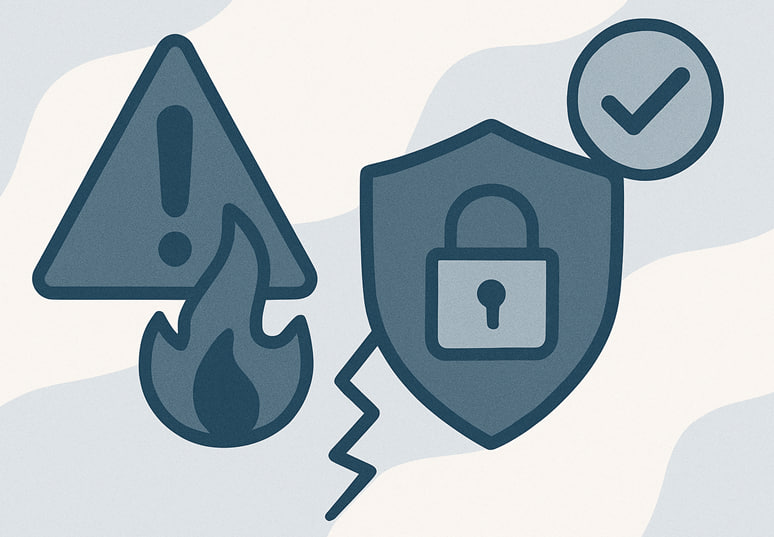Binance Smart Chain: Features and Differences

Contents
- Introduction
- What Is Binance Smart Chain
- Architecture and Consensus
- BEP-20 and Smart Contracts
- Opportunities with BSC
- Multichain and Bridges
- How BSC Compares to Other Blockchains
- Risks and Security Considerations
- Conclusion
Introduction
Binance Smart Chain is a blockchain created by the Binance team under Changpeng Zhao’s (CZ) leadership. BSC has become a key part of the exchange’s ecosystem and one of the most prominent platforms in the crypto world. Since its launch, the network quickly gained popularity among developers, investors, and everyday users.
This article will explain how BSC works, what opportunities it offers, what makes it unique, and what risks projects face within this network.
What Is Binance Smart Chain

Binance Smart Chain emerged to solve a significant problem. Binance’s leading network is Binance Chain. It was fast but too simple. It didn’t support complex decentralized applications. Developers lacked flexibility, and users wanted more features.
Binance Smart Chain (BSC) added what was missing. It became a separate network that operates alongside the main chain but can run smart contracts and support various decentralized services. This attracted developers and investors alike.
BSC provides developers with a convenient platform to create their tokens and launch DeFi protocols, NFT projects, and other blockchain services. It operates quickly, with minimal fees, and is fully compatible with Ethereum. This allows existing projects to be migrated without significant changes. Thanks to these advantages, many prefer BSC over slower and more expensive networks.
Architecture and Consensus

The core feature of BSC is its consensus mechanism, Proof of Staked Authority (PoSA), which is a hybrid of Proof of Stake and Proof of Authority.
How does it work? Network participants stake their tokens and vote for validators. These validators confirm blocks and receive rewards.
This approach offers several benefits:
-
High transaction processing speed
-
Low fees
-
Protection against spam and congestion
-
Network stability even with a growing number of users
PoSA helps BSC remain a fast, accessible, and stable platform for decentralized applications.
BEP-20 and Smart Contracts
BSC uses its own token standard—BEP-20- similar to Ethereum’s ERC-20 standard. This makes it easy for developers to create and integrate new tokens into existing projects.
Smart contracts on BSC run on the Ethereum Virtual Machine (EVM). This means that any code written for Ethereum also works on BSC. Developers don’t need to write everything from scratch.
BEP-20 has become the foundation for many cryptocurrencies within the BSC ecosystem. These are used in DeFi, games, NFTs, and more. EVM support makes it easy to build any decentralized solution on BSC.
Opportunities with BSC

High Speed and Low Fees
Binance Smart Chain processes blocks every 3 seconds, faster than other popular networks. Thus, users rarely experience transaction delays.
This is also important for developers. Users don’t lose money on high fees; developers can launch complex projects without worrying about congestion or costs.
This speed and accessibility open doors to various applications, from micropayments to gaming platforms and trading services.
Advanced DeFi Ecosystem
BSC has become home to many decentralized applications, particularly in the DeFi sector.
-
PancakeSwap is the largest decentralized exchange on BSC. It allows token swaps, farming, and the launch of new coins.
-
Venus is a lending platform. It lets users borrow against crypto collateral and earn interest by providing liquidity.
-
Beefy Finance is a service that helps users maximize farming yields. It automatically reinvests rewards and optimizes strategies to boost profits with minimal effort.
These projects allow BSC users to manage their assets without intermediaries, reducing risks and costs.
Multichain and Bridges
Binance Smart Chain doesn’t operate in isolation. It actively interacts with other networks.
Binance Bridge allows token transfers between BSC and networks like Ethereum, Polygon, and others. This is convenient when moving assets without using centralized exchanges.
Bridges help create a unified ecosystem where tokens can freely move and be used in various applications.
This approach makes BSC a practical platform for local projects and those aiming to operate across multiple networks.
How BSC Compares to Other Blockchains
Comparison with Ethereum and Avalanche
Comparison with Ethereum and Avalanche
Parameter | Binance Smart Chain (BSC) | Ethereum | Avalanche (C-Chain) |
Average block time | ≈ 3 seconds | ≈ 12–14 seconds | ≈ 2 seconds |
Average fee | A few cents | Several dollars | Around 1 cent |
Throughput | Higher (low load) | Lower (high load) | High |
Smart contract support | Yes | Yes | Yes |
EVM compatibility | Full | Native | Full |
Suitable for mass adoption | Yes | Limited by high gas costs | Partially |
dApp launch cost | Low | High | Medium |
Dependence on other networks | Independent | Base network | Independent |
Ecosystem maturity | High | Very high | Medium |
Developer entry threshold | Low | High | Medium |
Binance Smart Chain remains a convenient choice for those seeking a balance between speed, cost, and ease of use. It’s faster, cheaper than Ethereum, and easier to work with than Avalanche. For these reasons, many choose it to launch their projects.
Centralization vs Decentralization
BSC has a different structure from fully decentralized networks. There are only 21 validators, and they are not chosen at random. To become a validator, one must gain community support and stake a certain amount of tokens.
This approach makes the network faster but lowers its level of decentralization.
Pros:
-
Faster network performance
-
Low fees remain sustainable
-
Minimal burden on users and developers
Cons:
-
Network control is concentrated among a small number of validators
-
Collusion could lead to promoting personal interests
-
Censorship or interference with specific applications is possible
Despite this, BSC’s structure has proven resilient. The network operates stably under high load and remains a convenient platform for most tasks.
Compatibility and Asset Portability
BSC is fully compatible with the Ethereum Virtual Machine. This means Ethereum-based projects and tokens can be easily launched on BSC. Developers don’t need to rewrite code—they just adapt it for the new network and start working.
Additionally, users can transfer their tokens via bridges or special “wrappers.” This simplifies movement between ecosystems and allows assets to be used across different applications.
BSC makes blockchain interaction easy and accessible, especially for those familiar with Ethereum.
Risks and Security Considerations

Smart Contract Vulnerabilities
Smart contracts on BSC operate automatically. They don’t rely on humans but are susceptible to coding errors.
If a developer misses a vulnerability, an attacker could exploit it. There have been cases where hackers stole tens of millions of dollars through flawed contracts. For example, around $50 million was stolen in the Uranium Finance project due to a bug in the swap logic.
Projects should undergo a code audit to prevent such incidents—a review by an independent team of experts. Audits help identify weaknesses before launch. It’s also wise to use time-tested code templates and avoid adding unnecessary functions complicating the system.
Validator Role and Potential Issues
In BSC, validators make decisions—they confirm transactions and maintain the blockchain. There are only 21 of them, and they rotate through a voting process by token holders.
This speeds up the network but reduces decentralization. If a single group controls most validators, they can interfere with the network, blocking transactions or serving personal interests.
There’s also a risk of technical failures. The network can slow down or temporarily halt if validators make mistakes or go offline. To minimize these risks, BSC requires validators to have strong technical infrastructure and stable connectivity.
Conclusion
Binance Smart Chain is a fast and convenient blockchain. It supports smart contracts, decentralized applications, and multiple asset types. Its low fees and high speed suit many users and developers.
However, it also comes with risks. Validator centralization can affect security, and coding errors can lead to fund losses.
Before launching a project or investing in BSC, it’s essential to understand the network’s structure, audit smart contracts, and protect your assets.
If you follow these principles, Binance Smart Chain can be an excellent platform for building and scaling new blockchain projects.